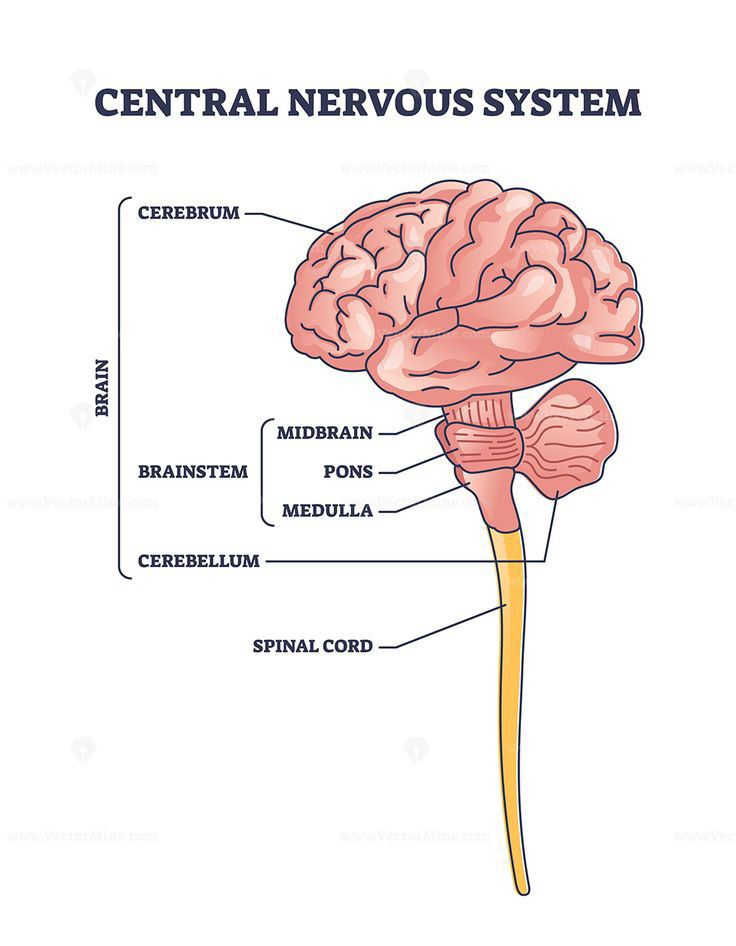NERVOUS COORDINATION
TABLE OF CONTENT:
2) What are the branches of Nervous System?
3) Structure of a Neuron.
4) Reflex and Voluntary Actions?
5) The Brain and the Spinal Cord.
1) What is Nervous System?
The nervous system is a complex network of cells that helps transmit and process information in the body. It includes the central nervous system (the brain and spinal cord) and the peripheral nervous system (nerves throughout the body). This system is essential for regulating functions like movement, sensation, and thought processes.
2) Branches of Nervous System.
a) Central Nervous System:
The Central Nervous System (CNS) is composed of the brain and spinal cord. The brain acts as the body's command center, processing thoughts, emotions, and controlling bodily functions. The spinal cord serves as a communication pathway, relaying sensory information from the body to the brain and transmitting motor commands from the brain to muscles and organs. The CNS plays a central role in coordinating and regulating bodily functions, as well as in human behavior and perception.
Consists: Brain and Spinal Cord.
b) Peripheral Nervous System:
The Peripheral Nervous System (PNS) is an extension of the nervous system beyond the Central Nervous System (CNS), which includes the brain and spinal cord. The PNS has two main branches:
i. Somatic Nervous System: It controls voluntary muscle movements and transmits sensory information to the CNS, allowing conscious movements and sensory perception.
ii. Autonomic Nervous System: This branch regulates involuntary bodily functions, including heart rate, digestion, and respiratory rate. It further divides into the sympathetic system, which prepares the body for action, and the parasympathetic system, which promotes relaxation.
The PNS is crucial for both conscious and unconscious bodily functions, ensuring the coordination of various systems to maintain overall health and balance.
A neuron, also known as a nerve cell, is a fundamental building block of the nervous system. It has a complex structure with several key components:
i. Cell Body (Soma): The cell body is the central part of the neuron and contains the nucleus, which houses the cell's genetic information. It is responsible for the metabolic processes of the neuron.
ii. Dendrites: Dendrites are branch-like extensions that radiate from the cell body. They receive signals and information from other neurons or sensory receptors, transmitting these signals to the cell body.
iii. Axon: The axon is a long, slender, and insulated fiber that carries electrical signals, known as action potentials, away from the cell body to transmit information to other neurons, muscles, or glands.
iv. Myelin Sheath: In many neurons, the axon is surrounded by a myelin sheath, which is composed of a fatty substance called myelin. This sheath insulates the axon and speeds up the transmission of electrical signals.
v. Axon Terminals: At the end of the axon, there are terminal branches that contain synaptic terminals. These structures allow the neuron to communicate with other neurons or target cells via synapses, which are tiny gaps where neurotransmitters are released.
vi. Synapse: The synapse is the junction where two neurons or a neuron and a target cell connect. Neurotransmitters are released from the axon terminals of one neuron into the synapse to transmit signals to the next cell.
Neurons vary in size and shape, but this basic structure is common to most of them. Neurons are specialized for the transmission of electrical and chemical signals, making them the functional units of the nervous system.
4) Reflex and Voluntary Actions:
i. Reflex Actions:
Reflex actions are rapid, automatic, and involuntary responses to a specific stimulus. They occur without conscious thought or decision-making.These actions are typically hardwired in the nervous system and designed for the body's immediate protection or response to a potentially harmful situation.
ii) Voluntary Actions:
In biology, voluntary actions are movements or behaviors that organisms, particularly animals, intentionally initiate and control in response to their environment or internal cues. These actions play a crucial role in an organism's survival, reproduction, and adaptation. Here is an example of voluntary actions in biology:
Foraging: Many animals, such as predators and herbivores, engage in voluntary actions when searching for food.
5) The Brain and Spinal cord:
The brain and spinal cord make up the central nervous system (CNS). The brain is responsible for processing information, controlling body functions, and enabling conscious thought. It's divided into several regions, each with specific functions, such as the cerebrum for higher cognition and the cerebellum for coordination.
The spinal cord is a long, tubular structure that extends from the base of the brain down the back. It serves as a communication pathway between the brain and the rest of the body, transmitting sensory information to the brain and motor commands from the brain to muscles and organs.
Together, the brain and spinal cord play a crucial role in regulating bodily functions, interpreting sensory input, and coordinating voluntary and involuntary actions. They are protected by the skull and vertebral column and are integral to our ability to think, move, and respond to our environment.
Assignment for the week
Explain:
a)Node of Ranvier
b)Axon Terminal
c)Schwann Cell
d)Myelin Sheath
e)Nucleus
To submit the assignment click SUBMIT.
Click Join to be in our WhatsApp Community.
Click Quiz to answer the quiz for today.







